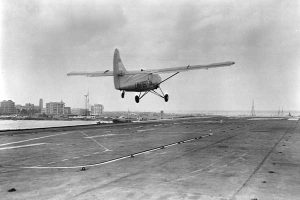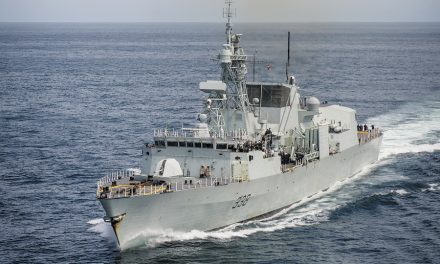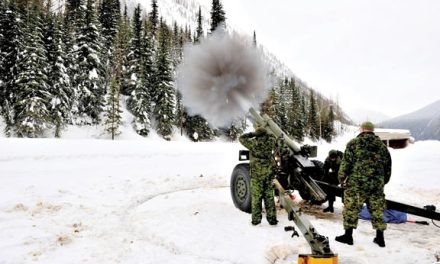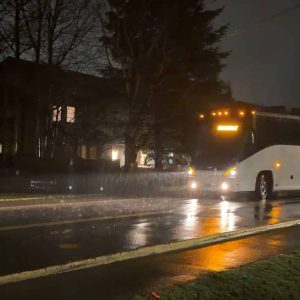One of the more delightful things about historical research is the interesting nuggets that I find when combing through old records and files. Often the nuggets that I uncover have nothing to do with the primary focus of my research (much to the chagrin of my boss), but they do often tend to generate a great story.
As a case in point, a few years ago I came across an approved unit crest for 115 Air Transport Unit (ATU).
Given the Egyptian image within the crest, I was curious to find out more about this particular unit of the Royal Canadian Air Force (RCAF).
In truth, I found many stories, but one of the best was that 115 ATU became the first, and to my knowledge, only RCAF unit to operate fixed-winged aircraft off the deck of one of Her Majesty’s Canadian Ships.
This particular RCAF composite unit was part of the Canadian contribution to the United Nations Emergency Force (UNEF). In its first iteration (there would be a second UNEF created in 1974), the UNEF was deployed beginning in November 1956 during the Suez Crisis.
In a nutshell, the Suez Crisis revolved around Egyptian President Gamal Abdel Nasser nationalizing the Anglo-French Suez Canal Company and the waterway from which the company got its name. When Israel and Egypt went to war in October of that year, the British and French governments, who had already worked out a deal with the Israelis, invaded Egypt ostensibly to safe-guard the canal.
It being the height of the Cold War, there was a significant danger that the Soviets (supporting Egypt) and the West (supporting Israel, Britain and France) might get drawn into the conflict, resulting in a major war. The UN brokered a ceasefire and, as a result of the efforts of the Canadian Minister of Foreign Affairs, Lester B. Pearson, a peacekeeping force was approved and deployed during the remainder of the year to serve as a buffer between the belligerents permitting a peaceful resolution of the conflict.
In the 10 years of its existence (peaceful resolutions being somewhat hard to come by in the Middle East), 115 ATU provided sterling service. However, for the purposes of this story, it is the very beginning that we must turn our attention to.
On Nov. 7, 1956, the Canadian government implemented the appropriately named Operation Rapid Step. In recognition of the need to transport large quantities of supplies to support the Canadian contribution to UNEF 1, the Royal Canadian Navy’s aircraft carrier HMCS Magnificent, or the Maggie as she was affectionately referred to, was recalled from Belfast, Ireland.
On Dec. 29, Maggie departed Halifax for Port Said, Egypt, carrying 100 tons of supplies, 233 vehicles, one H04S helicopter (the naval version of the Sikorsky S-55) and the mighty aerial armada that would form the backbone of 115 ATU: four single-engine CC-123 Otters.
Laugh not, Oh Reader, at the perceived utility of such an aircraft. The de Havilland Canada Otter was well-suited for the surveillance and light-transport duties it had to perform. Its short take off and landing (STOL) capabilities and overall ruggedness permitted it to operate from the less-than-ideal (i.e., virtually non-existent) airfields that 115 ATU used throughout its operational area.
Furthermore, from the perspective of the RCAF senior officers, whose minds might have been on other issues in 1956 – such as commitments to the North Atlantic Treaty Organization (NATO), the soon-to-be-implemented North American Air Defense Command (NORAD) agreement, and a potential new fighter (the CF-105 Arrow) – it was plentiful, cheap to operate and maintain, did not come with a high personnel bill and was considered to be effective in the kind of missions planned for the UN. The Otter had certainly proven its worth in the Far North.
By the second week of January 1957, the Maggie had arrived at Port Said. On Jan. 13, the RCAF maintainers on board sprang into action bringing forth the four Otters from where they were stored below decks, and began to get them into shape for takeoff. Finally, five days later they were ready to go.
With the Maggie at anchor, the aircrew revved their engines and took off down the rapidly dwindling flight deck. One by one they lumbered safely into the air…except for one. Just as it struggled to gain altitude, one of the Otters dropped its starboard wing and “kissed” the Maggie’s flight deck. Fortunately, the damage was minor and the four Otters made their way to their new home at El Arish, Egypt.
The departure of the Otters would be the first, and last time, that RCAF fixed-winged aircraft flew from a Canadian warship.
Eventually, 115 ATU added two RCAF CC-129 (DC-3) Dakotas to the fleet and operated primarily out of El Arish for the next decade. Of the four RCAF Otters, No. 3675 crashed near Rafah, Egypt, on April 15, 1957, and No. 3744 crashed at an airfield in Gaza Sept. 19, 1958. Both were written-off but fortunately there were no serious casualties.
The other two Otters, Nos. 3743 and 3745, were withdrawn from Egypt and replaced in due course. In the 10 years of operations in the Middle East, 115 ATU had many adventures, but I’ll save those stories for future telling.
As a closing note, if anyone out there has a colour image of 115 ATU’s crest, I would love to get a copy (william.march@forces.gc.ca) so that I can incorporate the colours in my records. And if you wish to learn more about 115 ATU, I recommend you check out www.115atu.ca, which is a site dedicated to the Air Force and peacekeeping.
-Major Bill March, Air Force Heritage & History










